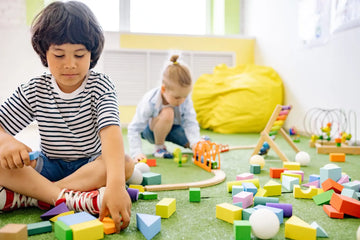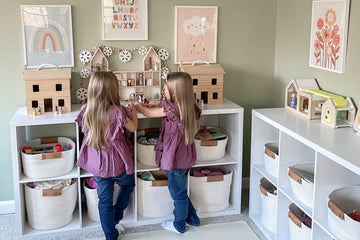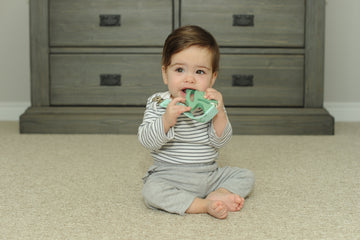As parents, we all want to see our children thrive, exploring their world with curiosity and creativity. But in a world filled with screens and battery-operated gadgets, finding ways to encourage imaginative play can be a challenge. Enter open-ended toys—the simple yet powerful tools that can unlock a world of creativity in your child. In this blog post, we’ll explore what makes open-ended toys so special, how they foster creativity, and some practical tips on how to incorporate them into your child’s playtime.
What Are Open-Ended Toys?
Open-ended toys are those magical items that don’t come with a fixed set of instructions or a single way to play. Unlike toys that have a predetermined purpose, open-ended toys can be used in countless ways, depending on your child’s imagination. Think of them as the raw materials for creativity—they provide the foundation, but it’s your child who decides what to build.
Examples of open-ended toys include blocks, play silks, wooden figures, and more. These toys don’t light up, talk, or move on their own; instead, they require your child to bring them to life through their ideas and creativity.

Why Open-Ended Toys Are Important for Creativity
One of the greatest benefits of open-ended toys is that they encourage children to think outside the box. Without a fixed way to play, children are free to explore, experiment, and create their own stories and scenarios. This kind of play is essential for developing creativity, problem-solving skills, and even emotional resilience.
Here’s how open-ended toys foster creativity:
Encouraging Imaginative Play: With no set rules or objectives, children are free to invent their own games and stories. A simple set of wooden blocks can become a castle, a spaceship, or even a zoo—whatever your child imagines it to be.
Developing Problem-Solving Skills: Open-ended toys often present challenges that require problem-solving. For example, when building a tower with blocks, your child has to figure out how to balance the pieces, which strengthens their ability to think critically.
Promoting Independent Play: Because open-ended toys don’t require instructions, children can engage with them on their own. This encourages independent play, which is crucial for building self-confidence and a sense of autonomy.
Supporting Emotional Expression: Sometimes, children use play to express their emotions and process their experiences. Open-ended toys allow them to explore different roles and scenarios, helping them understand and manage their feelings.

How to Incorporate Open-Ended Toys into Playtime
Now that we understand the benefits of open-ended toys, let’s talk about how to incorporate them into your child’s playtime. Here are some practical tips to get you started:
Start with Simple Toys You don’t need a lot of fancy toys to encourage creative play. Simple items like wooden blocks, play dough, or a set of colorful scarves can provide endless opportunities for imaginative play. For instance, a
Wooden Rainbow Stacking Toy can be used in countless ways—stacked into towers, sorted by color, or even used as bridges for toy cars.
Rotate Toys Regularly To keep playtime fresh and exciting, consider rotating your child’s toys every few weeks. This helps prevent boredom and keeps their creativity flowing. When toys are out of sight for a while, they become new and interesting again when reintroduced.
Create an Inviting Play Space Set up a designated play area that invites creativity. A simple rug, a few baskets of open-ended toys, and a cozy corner for reading can create an environment where your child feels inspired to explore and play. Make sure the space is organized and free of distractions like screens.
Let Your Child Lead One of the best things you can do is step back and let your child take the lead during playtime. Resist the urge to direct their play or offer suggestions. Instead, observe and support their ideas. This helps build their confidence and encourages them to think creatively.
Incorporate Nature Nature offers endless possibilities for open-ended play. Collecting sticks, stones, leaves, and other natural materials can provide your child with new ways to explore and create. A simple walk in the park can turn into a treasure hunt for items to add to their play.
Encourage Collaborative Play Open-ended toys are great for encouraging collaborative play with siblings or friends. When children play together, they learn to share ideas, negotiate roles, and solve problems as a team. This not only fosters creativity but also builds social skills.
Be Patient and Observant Creativity doesn’t always happen in an instant. Sometimes, children need time to warm up to a new toy or idea. Be patient and allow them the space to explore at their own pace. You might be surprised by what they come up with when given the time to experiment.

Open-Ended Toys in Action
Let’s take a look at a few examples of how open-ended toys can be used to spark creativity:
Wooden Animal Stacking Toy: This toy might seem straightforward at first glance, but it can be used in a variety of ways. Your child might stack the animals to see how high they can go, sort them by size, or even use them as characters in an imaginary zoo.
Kids Wooden Busy Block: This multifunctional toy offers endless possibilities for exploration. Your child might experiment with balancing, sorting, or building with the blocks, creating their own games and challenges along the way.
The Joy of Open-Ended Play
There’s something truly magical about watching your child lose themselves in imaginative play. With open-ended toys, you’re giving them the tools to explore, create, and discover the world in their own unique way. It’s a gift that goes beyond the toy itself—it’s an invitation to dream, invent, and see the world with endless possibilities.
So the next time you’re considering a new toy for your child, think about the possibilities it offers. Does it light up? Or does it light up their imagination? The difference is subtle but powerful. And remember, the best playtime is the kind that doesn’t come with a manual—just a whole lot of creativity and fun.








